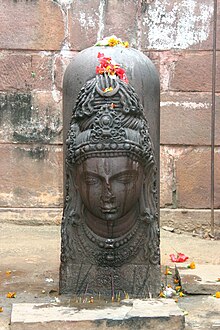

A mukhalinga or mukhalingam (Sanskrit: मुखलिङ्गम्, romanized: mukhaliṅga; literally "lingam with a face") is a lingam represented with one or more human faces in Hindu iconography.[1] A lingam is an aniconic representation of the Hindu god Shiva. Mukhalingas may be of stone or can be made of a metal sheath, which covers the normal lingam.
A mukhalinga generally has one, four, or five faces. Mukhalingas having four faces are also regarded to have an invisible fifth face on top of the linga. The four- and five-faced mukhalingas represent the five aspects of Shiva,[2] which also relate to the classical elements, and the cardinal directions.
While the formless aspect of Shiva is classified as nishkala (non-material), mukhalingas are classified as sakala nishkala (material-non-material).[3]
- ^ Stutley, Margaret and James (2019-04-09). A Dictionary of Hinduism: Its Mythology, Folklore and Development 1500 B.C.-A.D. 1500. Routledge. p. 345. ISBN 978-0-429-62754-5.
- ^ Rao, T. A. Gopinatha (1985). Elements of Hindu Iconography. Motilal Banarsidass Publisher. p. 97. ISBN 978-81-208-0878-2.
- ^ ALAYAM : The Hindu Temple;An Epitome of Hindu Culture; G.Venkataramana Reddy; Published by Adhyaksha; Sri Ramakrishna Math; ISBN 978-81-7823-542-4; Page 46